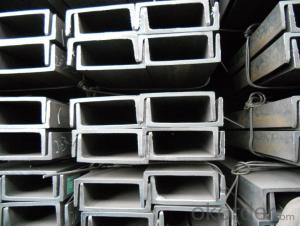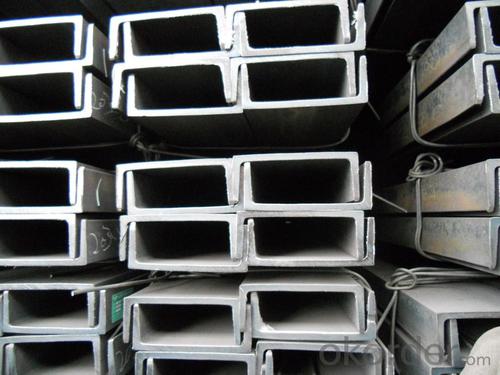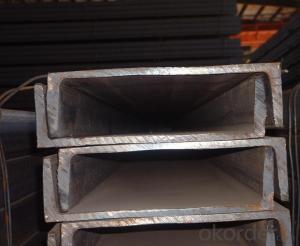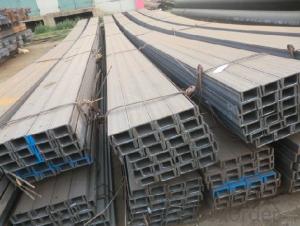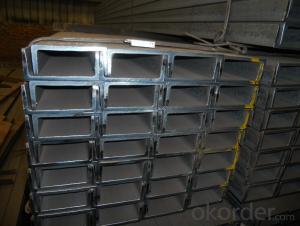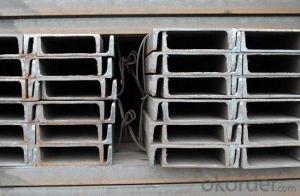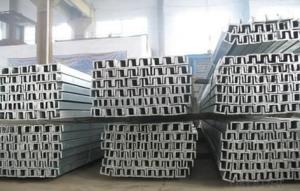Steel Channel 125-150mm
- Loading Port:
- China Main Port
- Payment Terms:
- TT OR LC
- Min Order Qty:
- -
- Supply Capability:
- -
OKorder Service Pledge
OKorder Financial Service
You Might Also Like
Specifications of JIS Channel Steel:
1. We are definitely speciallizing in manufacturing and supplying channel steel as per japanese standard, which is characterised with high mechanical strength and competitive prices.
| Standard | JIS G3192 |
| Material Grade | SS400 |
| Sizes | 50mm to 200mm |
| Sales Volume/Year | 3000MT |
| Destination Area | Middle East, Africa, Southeast Asia |
Size and Mass:
| Size (mm) | Mass (Kg/m) | Size (mm) | Mass (Kg/m) |
| 125*65*5.5 | 12.91 | 150*75*6.0 | 17.9 |
| 125*65*6.0 | 13.4 | 150*75*6.5 | 18.6 |
| 150*75*5.5 | 14.66 | | |
The mechanical property of JIS Channel Steel:
Grade | Yield Strength,N/mm² | Extension Strength N/mm² | |||
Thickness of Steel,mm | |||||
≦16 | >16-≦40 | >40-≦100 | >100 | ||
SS400 | ≧245 | ≧235 | ≧215 | ≧205 | 400-510 |
Package & Delivery of JIS Channel Steel:
1.The channel steel will be packed in bundle with steel wire at each end of every bundle and color marking in order to help the customer to recognize his goods more easily at sight.
2. And the channel steel could be loaded into 20ft or 40ft container, or by bulk cargo.If the weight of each bundle reaches more than 3.5 mt, the loading by break bulk cargo should be choosed.When the weight of each bundle reaches less than 3mt, the loading by container should be choosed.
3.As for the transportaion from mill to loading port, the truck will be usually used. And the maximum quantity for each truck is 40mt.
4.All in all, we could do in accordance with customer's request.
*If you would like to get our price, please inform us the size, standard/material and quantity. Thank you very much for your attention.
- Q: Can steel channels be used for access ladders?
- Yes, steel channels can be used for access ladders. Steel channels are often used in the construction industry for their high strength and durability. They can be easily welded or bolted together to create a sturdy ladder structure. Steel channels also provide stability and support, making them suitable for use as access ladders. Additionally, their corrosion resistance properties make them suitable for outdoor or industrial environments where exposure to moisture or chemicals may occur. However, it is important to ensure that the steel channels used for access ladders meet the necessary safety standards and regulations to ensure the safety of users.
- Q: How are steel channels used in the construction of airports or terminals?
- Steel channels are commonly used in the construction of airports or terminals for various purposes. They are primarily used for structural support, providing strength and stability to the overall building design. Steel channels are often utilized as framing elements for walls, ceilings, and floors, ensuring a robust and durable infrastructure. Additionally, they can be employed to create specific areas such as baggage handling systems, walkways, or platforms, enhancing efficiency and functionality within the airport or terminal.
- Q: How do steel channels perform in seismic zones?
- Steel channels perform well in seismic zones due to their inherent strength and flexibility. The channels are able to absorb and distribute seismic forces, reducing the risk of structural failure during earthquakes. Additionally, steel channels can be designed and reinforced to meet the specific requirements of seismic zones, making them a reliable choice for construction in such areas.
- Q: How do steel channels contribute to the stability of mezzanine floors?
- Steel channels are essential components in the construction of mezzanine floors and play a crucial role in contributing to their stability. These channels, also known as C-channels or C-sections, are made of high-strength steel and are specifically designed to provide structural support and reinforcement. One of the main ways steel channels contribute to the stability of mezzanine floors is by distributing the load evenly across the floor structure. Mezzanine floors are designed to accommodate heavy loads, such as machinery, equipment, or storage materials. The steel channels act as beams that bear the weight and transfer it to the vertical supports or columns. By distributing the load, they prevent localized stress concentration and ensure the overall stability of the floor. Furthermore, steel channels add rigidity to the mezzanine floor system. Due to their shape and structural properties, they offer excellent resistance to bending and torsion forces. This rigidity is crucial in preventing any excessive deflection or movement of the floor, especially when subjected to dynamic loads or vibrations. The stability provided by the steel channels enhances the safety and functionality of the mezzanine floor, allowing it to withstand heavy usage and ensure a secure work environment. Moreover, steel channels contribute to the overall durability and longevity of mezzanine floors. Steel is a highly durable material that can withstand a wide range of environmental conditions, such as temperature variations, moisture, and corrosion. By using steel channels, the structural integrity of the mezzanine floor system is enhanced, minimizing the risk of deformation, sagging, or structural failure over time. This durability ensures that the mezzanine floor can endure heavy loads for an extended period, reducing the need for frequent maintenance or replacement. In summary, steel channels play a vital role in contributing to the stability of mezzanine floors by distributing loads evenly, providing rigidity, and enhancing durability. Their structural properties ensure the safety, functionality, and longevity of mezzanine floors, making them an essential component in their construction.
- Q: Channel steel is mainly used in building structures
- Used in engineering structures to withstand greater forces. Mechanical frame structures are also commonly used.
- Q: Can steel channels be used for staircase handrails?
- Yes, steel channels can be used for staircase handrails. Steel channels provide strength and durability, making them a suitable choice for supporting and guiding people along staircases.
- Q: What are the different methods for anchoring steel channels to a foundation?
- Different methods exist for anchoring steel channels to a foundation, depending on the specific requirements and load capacity of the structure. Some commonly used methods are as follows: 1. Anchor Bolts: This method involves drilling holes into the foundation and inserting anchor bolts, which are then secured using nuts and washers. This creates a strong connection between the channel and the foundation. 2. Chemical Anchoring: When drilling into the foundation is not feasible or preferred, chemical anchoring can be employed. This method utilizes epoxy resin or adhesive to bond the steel channel to the foundation. The adhesive is applied to the base of the channel and pressed onto the foundation surface. After curing, a strong bond is formed between the channel and the foundation. 3. Welding: Another method for anchoring steel channels involves welding the base of the channel directly to the foundation surface. This method provides a permanent and robust connection; however, it necessitates skilled welders and may not be suitable for all applications. 4. Expansion Anchors: When a temporary or removable connection is required, expansion anchors are utilized. These anchors consist of a bolt or screw inserted into a pre-drilled hole in the foundation. As the bolt is tightened, it expands and wedges itself against the hole's sides, creating a secure connection. 5. Concrete Embedment: In certain cases, steel channels can be directly embedded into the concrete foundation. This method involves pouring concrete around the channel, completely surrounding and encasing the steel. Once the concrete hardens, a solid and permanent connection is established. To select the appropriate anchoring method for steel channels, factors such as load capacity, environmental conditions, and project requirements should be taken into consideration. Consulting a structural engineer or construction professional is advised to ensure the proper selection and installation of the anchoring method.
- Q: Can steel channels be used in wastewater treatment plants?
- Yes, steel channels can be used in wastewater treatment plants. Steel is a durable and corrosion-resistant material, making it suitable for use in environments with high moisture and chemical exposure. Steel channels can be used for various purposes in wastewater treatment plants, such as for conveying and directing the flow of water and wastewater, as well as for supporting and securing equipment and infrastructure. Additionally, steel channels can be easily fabricated and customized to meet specific design requirements and can withstand heavy loads and harsh operating conditions commonly found in wastewater treatment plants.
- Q: Can steel channels be used for roof structures?
- Indeed, roof structures can utilize steel channels. Construction frequently incorporates steel channels due to their robustness and endurance. They offer support for the structure and can function as purlins or rafters within roof systems. Steel channels possess the capability to endure substantial burdens and contribute stability to the entire framework. Furthermore, their fabrication and installation are hassle-free, rendering them a favored option for roof construction. Moreover, steel channels exhibit resistance to fire, corrosion, and pests, establishing them as a dependable and enduring choice for roof structures.
- Q: What are the different methods of surface treatment for steel channels?
- There are several different methods of surface treatment for steel channels, each offering unique benefits and characteristics. Some of the commonly used methods are: 1. Hot-dip galvanizing: This method involves immersing the steel channels in a bath of molten zinc. The zinc coating provides excellent corrosion resistance and protects the steel from rust and other environmental factors. It is a popular choice for outdoor applications where long-term durability is required. 2. Powder coating: Powder coating is a dry finishing process in which a powdered polymer is electrostatically applied to the steel channels and then cured under heat. This method provides a durable and attractive finish, with a wide range of colors and textures available. Powder coating also offers excellent resistance to chipping, scratching, and fading. 3. Electroplating: Electroplating involves depositing a thin layer of metal, such as chromium or nickel, onto the surface of the steel channels through an electrochemical process. This method enhances the corrosion resistance and improves the appearance of the channels. Electroplating can also increase the hardness and wear resistance of the steel. 4. Paint coating: Paint coating is a common method where a layer of paint is applied to the surface of the steel channels. This method provides a decorative finish and also protects the steel from corrosion and weathering. Different types of paints, such as epoxy, acrylic, or polyurethane, can be used based on the specific requirements of the application. 5. Anodizing: Anodizing is primarily used for aluminum, but it can also be applied to steel channels. This process involves creating an oxide layer on the surface of the metal through an electrochemical reaction. Anodizing improves the corrosion resistance, provides a decorative finish, and can also enhance the wear resistance of the steel. 6. Phosphating: Phosphating is a chemical process that involves applying a phosphate coating to the surface of the steel channels. This method improves the adhesion of paint or other coatings, provides a protective layer against corrosion, and can also enhance the lubricity of the steel. Each method of surface treatment for steel channels has its own advantages and is suitable for different applications. The choice of the treatment method depends on factors such as the intended use of the channels, the environmental conditions, and the desired appearance and performance characteristics.
Send your message to us
Steel Channel 125-150mm
- Loading Port:
- China Main Port
- Payment Terms:
- TT OR LC
- Min Order Qty:
- -
- Supply Capability:
- -
OKorder Service Pledge
OKorder Financial Service
Similar products
Hot products
Hot Searches
Related keywords
